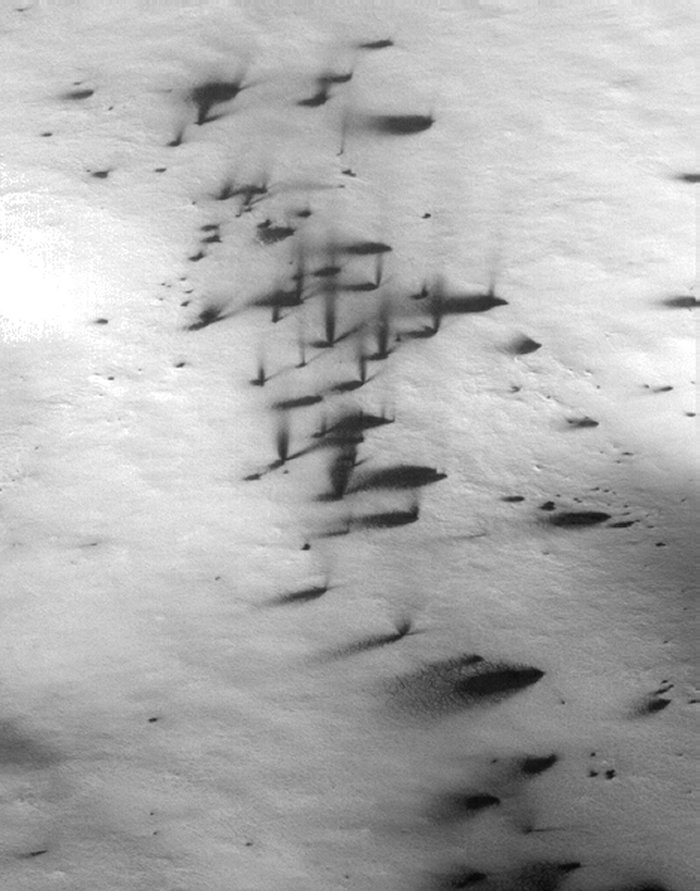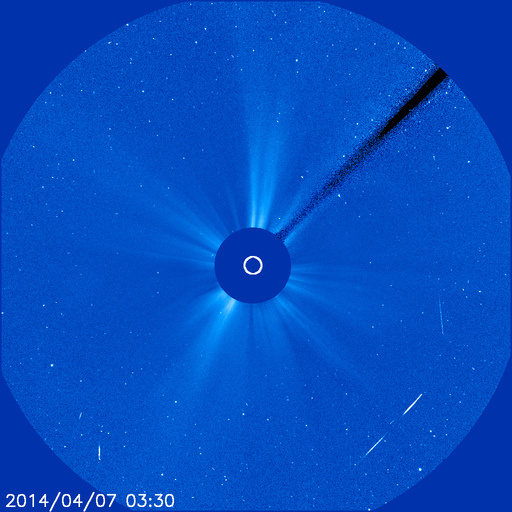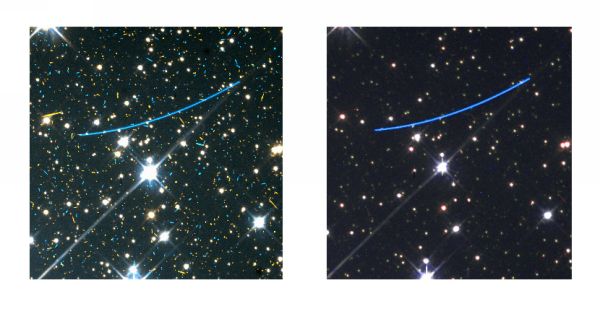It looks like you're using an Ad Blocker.
Please white-list or disable AboveTopSecret.com in your ad-blocking tool.
Thank you.
Some features of ATS will be disabled while you continue to use an ad-blocker.
share:
Miniscuzz
reply to post by Phage
First, Mars has no atmosphere to interact with incoming particles to cause a cosmic ray on the ground.
SNIP
Mod Note: ALL MEMBERS: We expect civility and decorum within all topics - Please Review This Link.edit on 4/6/2014 by Blaine91555 because: Rude comment removed for TAC violation.
Mars does have an atmosphere. It is composed mostly of Carbon dioxide, and trace gases. It may be thinner than earth's, but it does indeed exist.
reply to post by Miniscuzz
Can you say "reflected sunlight" on a relatively smooth rock or other object!
Can you say "reflected sunlight" on a relatively smooth rock or other object!
I think it's time to put to rest that this is some sort of cosmic ray being caught with a camera. First, once one studies the makeup of the mast and
the position of the Nav-Cam sensors, it becomes obvious that the odds a cosmic ray was able to hover 10ft. above the ground and slam into the sensor
is NIL. Mostly because according to the picture, there's a large hill directly in front of the camera some distance away. That cosmic ray would've
slammed into IT long before reaching the mm wide sensor.
However, I also did some digging on those cameras and came up with some other relative information.
First, those Nav-Cams use Visual Light. Let that sink in for a second...VISUAL LIGHT. Are cosmic rays able to be seen using a visual light source? NO. Cosmic rays aren't even in the vicinity of the visual light spectrum, because if they were, every single picture captured by those Nav-Cams would be bombarded with cosmic ray light. They aren't.
Secondly, let's assume for one hot second that Cosmic Rays were visible in the visual light spectrum. Both Nav-Cams have band-pass filters which wouldn't even allow for them to catch any residual light from any source...most especially from a cosmic ray. Those cams aren't DSLR cameras either. Meaning that they do not contain the metal oxide semi-conductor chips which is necessary (along with very long exposure times) to be able to capture cosmic rays in the first place.
Thirdly, while I agree that conventional cameras can and do capture residuals from cosmic rays...they do so on Earth only because the atmosphere is stripping off particles which allow for certain cameras to catch residual light. This doesn't happen on Mars, so I can't for the life of me see how visual light cameras on a planet with little/no atmosphere could catch any light source which isn't even in the visual light spectrum.
I don't know what the light source is, but it isn't from some cosmic ray gibberish. In fact, I haven't seen one image out of 65+ pages of google images for cosmic rays that even come close to resembling the one in this thread. All pics of cosmic rays I have seen are the exact same intensity from head to tail in the streak and they ALL go from side to side... not up/down. They also do not look as if the light is diffused as it is in the picture here. As the light travels (seemingly) from ground up (brightest to lightest) the pixels become white, off-white, grey, dark grey. That isn't consistent with capturing a cosmic ray.
Now...for those of you claiming that it's some sort of "missing packet info": That isn't possible with the computer program that the Nav-Cams using. These are "tactical" cams deemed most important to the mission. They work in tandem with two onboard computers using "ICER". ICER is a wavelet-based image compression file format used by the NASA Mars Rovers. ICER has both lossy and lossless compression modes.
ICER-3D exploits 3D data dependencies in part by using a 3-D wavelet decomposition. The particular decomposition used by ICER-3D includes additional spatial decomposition steps compared to a 3-D Mallat decomposition. This modified decomposition provides benefits in the form of quantitatively improved rate-distortion performance and in the elimination of spectral ringing artifacts.
Further reading on ICER suggests that it eliminates almost ALL picture artifacts and has no packet losses through deep-space channels. Read the Wiki for further information on the subject.
While I continue providing facts to support my theory, others who won't be named think that they can just pop into a thread and claim "facts" and then leave claiming a "debunk". When in FACT, the FACTS seem to support the exact opposite.
I'll await a response on how visual light cameras are able to take pictures of something that isn't even in the visual light spectrum. This ought to be good...
However, I also did some digging on those cameras and came up with some other relative information.
First, those Nav-Cams use Visual Light. Let that sink in for a second...VISUAL LIGHT. Are cosmic rays able to be seen using a visual light source? NO. Cosmic rays aren't even in the vicinity of the visual light spectrum, because if they were, every single picture captured by those Nav-Cams would be bombarded with cosmic ray light. They aren't.
Secondly, let's assume for one hot second that Cosmic Rays were visible in the visual light spectrum. Both Nav-Cams have band-pass filters which wouldn't even allow for them to catch any residual light from any source...most especially from a cosmic ray. Those cams aren't DSLR cameras either. Meaning that they do not contain the metal oxide semi-conductor chips which is necessary (along with very long exposure times) to be able to capture cosmic rays in the first place.
Thirdly, while I agree that conventional cameras can and do capture residuals from cosmic rays...they do so on Earth only because the atmosphere is stripping off particles which allow for certain cameras to catch residual light. This doesn't happen on Mars, so I can't for the life of me see how visual light cameras on a planet with little/no atmosphere could catch any light source which isn't even in the visual light spectrum.
I don't know what the light source is, but it isn't from some cosmic ray gibberish. In fact, I haven't seen one image out of 65+ pages of google images for cosmic rays that even come close to resembling the one in this thread. All pics of cosmic rays I have seen are the exact same intensity from head to tail in the streak and they ALL go from side to side... not up/down. They also do not look as if the light is diffused as it is in the picture here. As the light travels (seemingly) from ground up (brightest to lightest) the pixels become white, off-white, grey, dark grey. That isn't consistent with capturing a cosmic ray.
Now...for those of you claiming that it's some sort of "missing packet info": That isn't possible with the computer program that the Nav-Cams using. These are "tactical" cams deemed most important to the mission. They work in tandem with two onboard computers using "ICER". ICER is a wavelet-based image compression file format used by the NASA Mars Rovers. ICER has both lossy and lossless compression modes.
ICER-3D exploits 3D data dependencies in part by using a 3-D wavelet decomposition. The particular decomposition used by ICER-3D includes additional spatial decomposition steps compared to a 3-D Mallat decomposition. This modified decomposition provides benefits in the form of quantitatively improved rate-distortion performance and in the elimination of spectral ringing artifacts.
Further reading on ICER suggests that it eliminates almost ALL picture artifacts and has no packet losses through deep-space channels. Read the Wiki for further information on the subject.
While I continue providing facts to support my theory, others who won't be named think that they can just pop into a thread and claim "facts" and then leave claiming a "debunk". When in FACT, the FACTS seem to support the exact opposite.
I'll await a response on how visual light cameras are able to take pictures of something that isn't even in the visual light spectrum. This ought to be good...
edit on 7-4-2014 by Miniscuzz because: (no reason given)
Miniscuzz
I'll await a response on how visual light cameras are able to take pictures of something that isn't even in the visual light spectrum. This ought to be good...
It isn't "taking a picture" of the cosmic ray (more correctly, particle) itself. It's a result of the interaction of the particle with the inner-workings of the camera. And it doesn't have to enter the lens of the camera to do its thing. Cosmic rays are able to penetrate some pretty stout materials. The camera probably doesn't pose much of a challenge to a cosmic "ray".
reply to post by Miniscuzz
Made a stereoscopic gif to more easily see its place or lack thereof in 3 dimensions.

imgur.com...
Made a stereoscopic gif to more easily see its place or lack thereof in 3 dimensions.

imgur.com...
reply to post by Ananake
You may want to look at the foreground, add a few more frames either end and do a slow motion video and also quick fast forward.
Very odd. ...
You may want to look at the foreground, add a few more frames either end and do a slow motion video and also quick fast forward.
Very odd. ...
zetnom
How about an ice geyser in the background triggered by the passing light? the sun appears to be on the horizon of the photo.
Ice Geysers - BBC NEWS 2006
They should take this picture and show it to every oil CEO and tell them these are actually "oil geysers" on Mars...... the space program would NEVER suffer from funding issues again and I bet we would have oil drilling platforms on Mars by 2020
reply to post by greyer
Or maybe the moon tower has the same explanation, a ray hitting the camera lens at just the right angle to affect the "stuff" above it in the photograph (in the case of the rover, the pixels).
Or maybe the moon tower has the same explanation, a ray hitting the camera lens at just the right angle to affect the "stuff" above it in the photograph (in the case of the rover, the pixels).
reply to post by Miniscuzz
This camera is outside the atmosphere. This camera uses visible light. This camera catches many cosmic ray strikes.
The camera is not recording light from cosmic rays. It is recording cosmic rays striking the camera sensor.
mars.jpl.nasa.gov...
mars.jpl.nasa.gov...
Thirdly, while I agree that conventional cameras can and do capture residuals from cosmic rays...they do so on Earth only because the atmosphere is stripping off particles which allow for certain cameras to catch residual light.
This camera is outside the atmosphere. This camera uses visible light. This camera catches many cosmic ray strikes.
The camera is not recording light from cosmic rays. It is recording cosmic rays striking the camera sensor.
All pics of cosmic rays I have seen are the exact same intensity from head to tail in the streak and they ALL go from side to side... not up/down. They also do not look as if the light is diffused as it is in the picture here.
mars.jpl.nasa.gov...
mars.jpl.nasa.gov...
edit on 4/7/2014 by Phage because: (no reason given)
it certainly is incredibly interesting so that is something to look into , at this point we can only speculate.
maybe its some form of martian phenomenon as yet undiscovered until now !
maybe its some form of martian phenomenon as yet undiscovered until now !
If it was a dead pixel wouldn't we see that same dead pixel in that same spot for all the pictures to come after the one taken showing the light???
reply to post by Miniscuzz
The same way a camera that exposes for too long shows thermal noise.
Thermal noise is not "visible light" either. Yet a digital camera can show that if conditions are right for it.
A Charged Couple Device can show "light" where none exists if enough energy biases the gate.
Does not mater where the energy comes from. Normal operation means that it came from the visible light it was exposed to. However, as long as something makes the gate, it will think something was there.
A Cosmic Ray is a high energy particle. It has more than enough energy to make that gate.
No visible light required. Only energy is what needs to be there.
The atmosphere of Mars is so thin, that it is quite possible for cosmic rays to traverse through it from a low enough angle and strike the camera. There is more than enough sky in the image to show that there is enough room for the ray to have originated from close to the horizon to quite a ways up in the sky.
The amount of energy in a cosmic ray is more than enough to bias not only a single gate, but many around it. Hence how it looks.
The same way a camera that exposes for too long shows thermal noise.
Thermal noise is not "visible light" either. Yet a digital camera can show that if conditions are right for it.
A Charged Couple Device can show "light" where none exists if enough energy biases the gate.
Does not mater where the energy comes from. Normal operation means that it came from the visible light it was exposed to. However, as long as something makes the gate, it will think something was there.
A Cosmic Ray is a high energy particle. It has more than enough energy to make that gate.
No visible light required. Only energy is what needs to be there.
The atmosphere of Mars is so thin, that it is quite possible for cosmic rays to traverse through it from a low enough angle and strike the camera. There is more than enough sky in the image to show that there is enough room for the ray to have originated from close to the horizon to quite a ways up in the sky.
The amount of energy in a cosmic ray is more than enough to bias not only a single gate, but many around it. Hence how it looks.
jhn7537
If it was a dead pixel wouldn't we see that same dead pixel in that same spot for all the pictures to come after the one taken showing the light???
I think how Phage explained it (and we all had this discussion hours before this thread was put up, btw, on the Mars anomalies thread) was that it's not a dead camera pixel, but one that hit these particular photos with such an amount of energy that they bled into the pixels above them to make it look like it was a "beam" of light when it was an energy overload. But I'm not a camera expert.
Here is Phage's answer explaining the multi-pixel overflow, and the discussion itself comes from the previous page and goes on from Phage's answer:
www.abovetopsecret.com...
edit on 7-4-2014 by Aleister because: (no reason given)
reply to post by Miniscuzz
I'm not sure what the image depicts but just wanted to say that I am thoroughly enjoying the debate on this image.
It's rare to see both sides so well presented.
Keep up the good work, guys!
I'm not sure what the image depicts but just wanted to say that I am thoroughly enjoying the debate on this image.
It's rare to see both sides so well presented.
Keep up the good work, guys!
jhn7537
If it was a dead pixel wouldn't we see that same dead pixel in that same spot for all the pictures to come after the one taken showing the light???
Thank you. All this talk about "dead pixels" is driving me crazy. You're right, if there were dead pixels they would show up in subsequent photos in the same spot.
I, myself, don't believe these are dead pixels. Hot pixels can come and go, depending on the ISO and the length of exposure, but dead pixels would be in the same spot in every image the camera took.
Here is some info regarding the difference between hot, dead, and other pixel problems: Pixel Probs
I wouldn't doubt there was some static / interference of some sort when downloading the image from the rover causing an anomaly like we see. I am
surprised it doesn't happen more often. 34.8 million + miles is a long way for radiowaves to travel carrying pixel data for high resolution images.
Especially through space, which consists of various energy sources from all over the place.
new topics
-
Maestro Benedetto
Literature: 25 minutes ago -
Is AI Better Than the Hollywood Elite?
Movies: 34 minutes ago -
Las Vegas UFO Spotting Teen Traumatized by Demon Creature in Backyard
Aliens and UFOs: 4 hours ago -
2024 Pigeon Forge Rod Run - On the Strip (Video made for you)
Automotive Discussion: 4 hours ago -
Gaza Terrorists Attack US Humanitarian Pier During Construction
Middle East Issues: 5 hours ago -
The functionality of boldening and italics is clunky and no post char limit warning?
ATS Freshman's Forum: 6 hours ago -
Meadows, Giuliani Among 11 Indicted in Arizona in Latest 2020 Election Subversion Case
Mainstream News: 6 hours ago -
Massachusetts Drag Queen Leads Young Kids in Free Palestine Chant
Social Issues and Civil Unrest: 7 hours ago -
Weinstein's conviction overturned
Mainstream News: 8 hours ago -
Supreme Court Oral Arguments 4.25.2024 - Are PRESIDENTS IMMUNE From Later Being Prosecuted.
Above Politics: 10 hours ago
top topics
-
Krystalnacht on today's most elite Universities?
Social Issues and Civil Unrest: 10 hours ago, 9 flags -
Supreme Court Oral Arguments 4.25.2024 - Are PRESIDENTS IMMUNE From Later Being Prosecuted.
Above Politics: 10 hours ago, 8 flags -
Weinstein's conviction overturned
Mainstream News: 8 hours ago, 7 flags -
Gaza Terrorists Attack US Humanitarian Pier During Construction
Middle East Issues: 5 hours ago, 7 flags -
University of Texas Instantly Shuts Down Anti Israel Protests
Education and Media: 12 hours ago, 6 flags -
Massachusetts Drag Queen Leads Young Kids in Free Palestine Chant
Social Issues and Civil Unrest: 7 hours ago, 6 flags -
Meadows, Giuliani Among 11 Indicted in Arizona in Latest 2020 Election Subversion Case
Mainstream News: 6 hours ago, 5 flags -
Las Vegas UFO Spotting Teen Traumatized by Demon Creature in Backyard
Aliens and UFOs: 4 hours ago, 3 flags -
2024 Pigeon Forge Rod Run - On the Strip (Video made for you)
Automotive Discussion: 4 hours ago, 2 flags -
Any one suspicious of fever promotions events, major investor Goldman Sachs card only.
The Gray Area: 14 hours ago, 2 flags
active topics
-
My Poor Avocado Plant.
General Chit Chat • 77 • : JonnyC555 -
University of Texas Instantly Shuts Down Anti Israel Protests
Education and Media • 219 • : marg6043 -
New whistleblower Jason Sands speaks on Twitter Spaces last night.
Aliens and UFOs • 61 • : Ophiuchus1 -
Is AI Better Than the Hollywood Elite?
Movies • 2 • : 5thHead -
Gaza Terrorists Attack US Humanitarian Pier During Construction
Middle East Issues • 25 • : CarlLaFong -
VP's Secret Service agent brawls with other agents at Andrews
Mainstream News • 57 • : Guyfriday -
Mood Music Part VI
Music • 3102 • : Hellmutt -
Las Vegas UFO Spotting Teen Traumatized by Demon Creature in Backyard
Aliens and UFOs • 9 • : Ophiuchus1 -
British TV Presenter Refuses To Use Guest's Preferred Pronouns
Education and Media • 164 • : Annee -
Maestro Benedetto
Literature • 0 • : BrotherKinsMan





